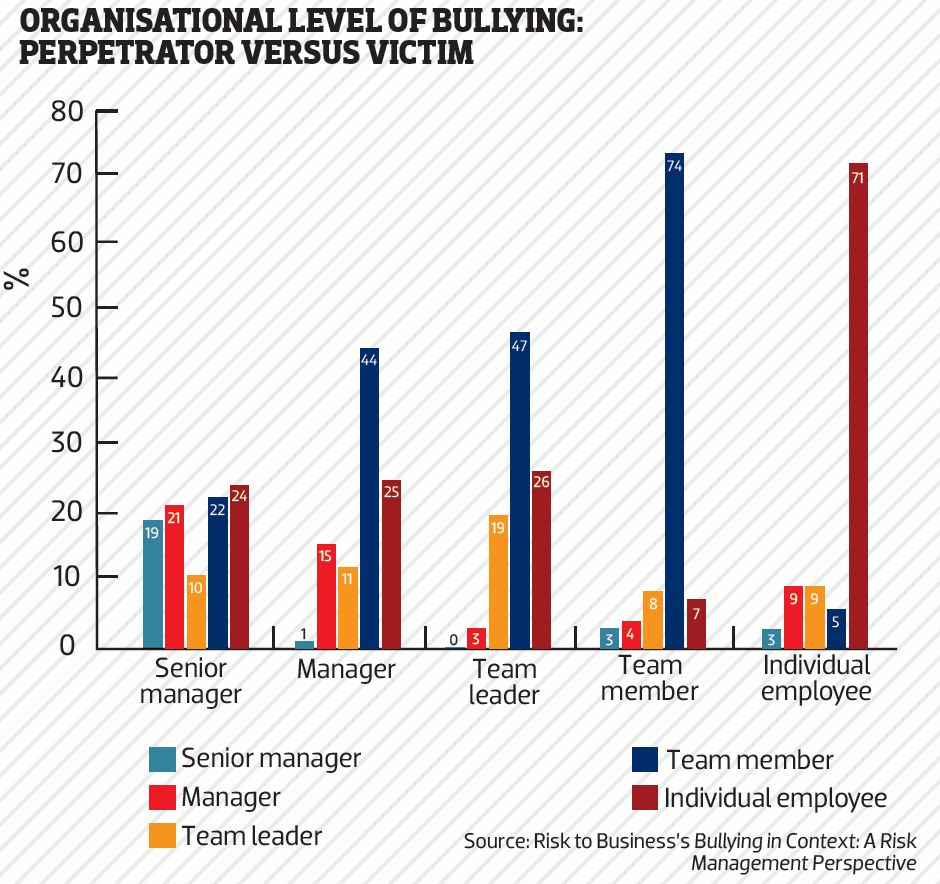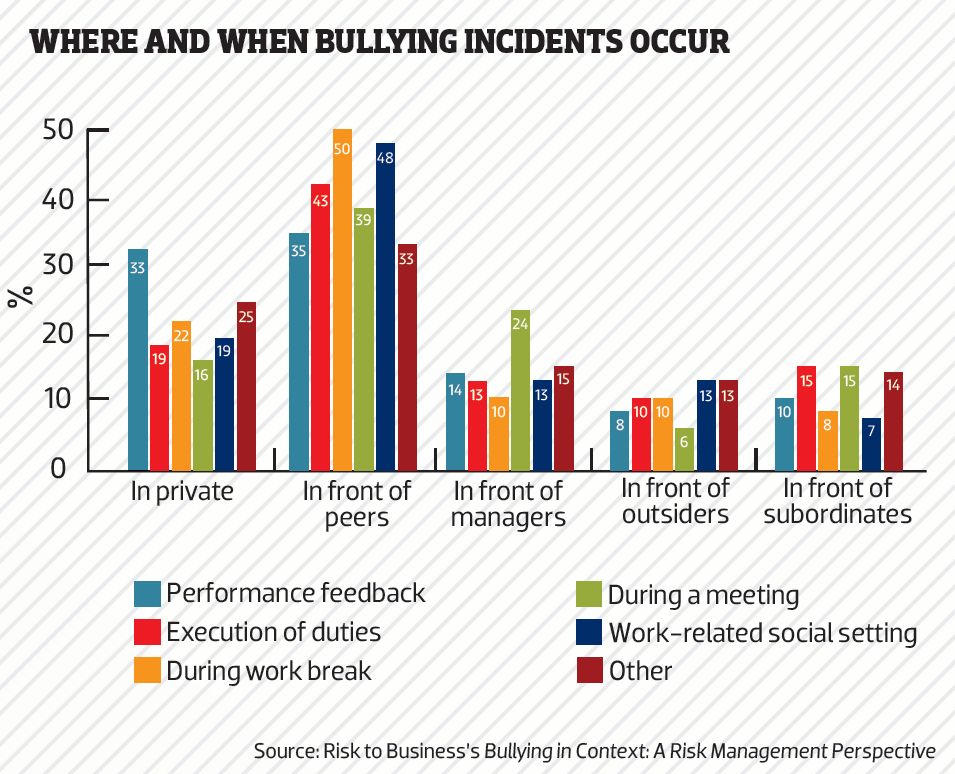 RtB's Stuart King
Workplace bullying is an old enemy of any seasoned HR professional. New research has revealed the true nature of the problem. Cameron Edmond outlines what can be done about it
RtB's Stuart King
Workplace bullying is an old enemy of any seasoned HR professional. New research has revealed the true nature of the problem. Cameron Edmond outlines what can be done about it
Workplace bullying is a problem that has persisted for years. Despite ongoing adjustments to legislation, workplace initiatives, and many organisations adopting zero-tolerance policies, Australia continues to be rocked by the devastating impact of workplace bullying.
The Australian Productivity Commission estimates that workplace bullying costs Australia $6bn–$36bn per year, with research from Risk to Business (RtB) suggesting that as many as 30% of workers in Australia have experienced workplace bullying in the last 12 months.
ROUND ONE: WHERE ARE WE?
The current landscape views bullying as being centred on notions of power. In addition, many professionals divide bullying into categories based on how the bullying relates to the organisation’s hierarchy: ‘upwards bullying’ is used to refer to a manager being bullied by a subordinate; ‘downwards bullying’ to indicate the reverse; and ‘bullying’ simply indicates bullying between two colleagues. Experts, however, believe these notions are flawed.
RtB’s research,
Bullying in Context: A Risk Management Perspective, provided exclusively to
HR Director, has found that bullying is much more heavily linked to the ‘games and tournaments’ played in an organisation and the general business culture than to arbitrary ideas of power over others. “Organisations determine the games that need to be played for people to be successful, and the systems and processes determine the rules of the game that needs to be played … we are dealing with humans, and nearly everybody bends the rules when they are competing, because that’s how they win,” Stuart King, managing director of RtB, tells
HRD.
In addition to shifting focus away from viewing bullying as a power struggle and understanding the role the workplace’s systems and games play, Kate Carnell, CEO of beyondblue, feels that splitting the concept of bullying into separate facets, such as upwards bullying, detracts from the issue.
“I think we’ve got to say that bullying is not acceptable under any circumstances, whoever might be doing it,” Carnell says. “Bullying is bullying, and no tolerance for it means no tolerance for it.” While stress, anxiety, depression, and in some cases suicidal behaviour are known to occur in the victims of bullying, what often remains unreported is the ‘bystander’ effect.
When bullying occurs in the workplace, others will witness or in other ways be aware of it. The bullying can then have an effect on these bystanders. Carnell explains this can swing one of two ways: either the bystanders become fearful of a bullying culture in the workplace (especially if they are new to the workplace); or it can mean these bystanders will adopt similar bullying approaches to try to move up the hierarchy of the organisation.
“If it is seen that bullying-type behaviour is allowed in a workplace – particularly if it is successful in achieving whatever the bully’s ends are – then many people respond by believing that is the way this company or organisation works so they will adopt a similar approach,” Carnell adds.
 Organisational Level of Bullying (click on image to enlarge)
ROUND TWO: HOW DO WE SOLVE IT?
Organisational Level of Bullying (click on image to enlarge)
ROUND TWO: HOW DO WE SOLVE IT?
The revelation surrounding bullying’s link to workplace games and tournaments – which are fundamentally tied to the culture of the organisation – suggests the problem is indeed solvable.
The way these tournaments and games manifest is dictated by the structure of the organisation and how success is measured. When pay increases or bonuses are linked to performance, these competitive tournaments begin to play out, as one’s lifestyle and financial well-being is on the line.
“If you tell someone they are going to get a shiny red sports car if they hit their target, they will move hell and high water,” King explains. “If you tell the team if they hit their targets they are all going to get to take part in an event together, they will work together.”
In addition to encouraging collaboration as an HR matter, organisations must move towards establishing their purpose as one that is more meaningful than hitting targets.
“The fundamental question of why a business is in business drives everything,” King says.
Understanding and explaining to staff the true purpose of the organisation – what service it is trying to provide and why, what meaning their work has, etc – will lay the foundation for a workforce that is not driven by competition and numbers and is instead moved by purpose. This leads to a less hostile work environment in which bullying is less likely to occur.
Furthermore, identifying risks in the organisation, such as small indiscretions and insecure personalities, is important in preventing a culture of bullying that may be bubbling beneath the surface.
“Once bad behaviour or bending the rules starts, it gains momentum, and that’s why we shouldn’t condone small indiscretions. This is the leadership component,” King explains.
Most importantly, business leaders must take a strong stance against bullying to help perpetuate a culture that proactively stamps it out. In the same way that bystanders can be influenced by bullies who dominate in the workforce, so too can leaders influence those around them if they take a stance.
Sadly, RtB research indicates that many organisations don’t do enough when evidence of bullying presents itself: 6% of Aussie workers claimed their employer made things worse; 23% of employers turned a blind eye; 40% did nothing at all; 4% victimised the person who complained; and only 16% made things better.
Informing all employees of the workplace policies regarding bullying is important too, so they can then feel confi dent and empowered to speak up if they see bullying occur.
“It is important that people understand what their options are if they see bullying incidents,” Carnell says. “We can never stop bullying if nobody says anything.”
Championing a stance of anti-bullying through leadership is something King feels all organisations must strive for – and there are no excuses.
“It only takes common sense, leadership, wisdom and good governance for a CEO or a board to ensure that a workplace is safe and, better still, harmonious,” he says. “Helpful mechanisms are available for every company, every employer, every executive and every employee.”
 When Bullying Occurs (click on image to enlarge)
When Bullying Occurs (click on image to enlarge)
---
THE LEGAL CRACKDOWN AND WHY AUSTRALIA NEEDS IT
Changes to the Fair Work Act (2009) took effect on 1 January 2014, with the aim of cracking down on workplace bullying.
The changes include defining workplace bullying as “repeated, unreasonable behaviour directed towards a worker or a group of workers that creates a risk to health and safety”, and empower the
Fair Work Commission to investigate and handle complaints of bullying.
While experts like Jessica Fletcher of law firm Hall & Wilcox fear that these new provisions will result in a surge in bullying complaints by employees out to rort the system and stop reasonable management action from taking place, the landscape before the changes wasn’t pretty.
September 2006 saw the tragic death of Brodie Panlock, who took her own life after relentless humiliation and bullying at the hands of her co-workers at a Hawthorn cafe. A wake-up call for the community, Panlock’s death drove home the serious consequences bullying has on its victims, leading to the introduction of Victoria’s Brodie’s Law in 2011, which treats serious bullying as a criminal offence punishable by up to 10 years in jail.
---
PRE-EMPTIVE STRIKE
Doing nothing is not an option. As you work towards remedying broader problems in your organisation that may contribute to bullying, Risk to Business recommends the following steps be taken now:
- Develop short- and long-term strategies that reduce the opportunity for workplace bullying to occur through organisational systems, processes and structures
- Expose behavioural risks that are currently invisible
- Take a leadership position at every level of the organisation and at every opportunity. Ask the hard questions, seek out risks, show others what leaders stand for and how work is really done in your organisation, and take action to protect organisational values
- Engage competent, licensed and qualified third-party specialist service providers to open up lines of communication and independent employee complaint responses
- Develop and implement a long-term strategy based around organisational values to raise awareness and impact positively on employee engagement and recognition



